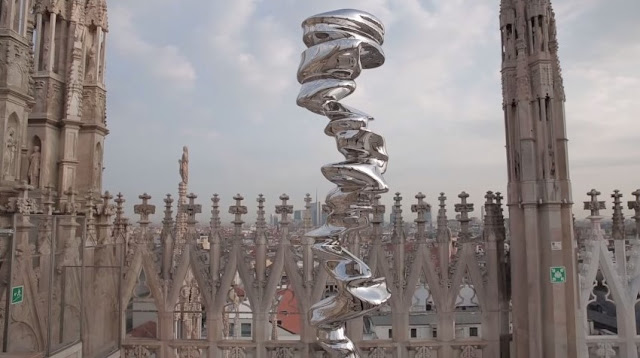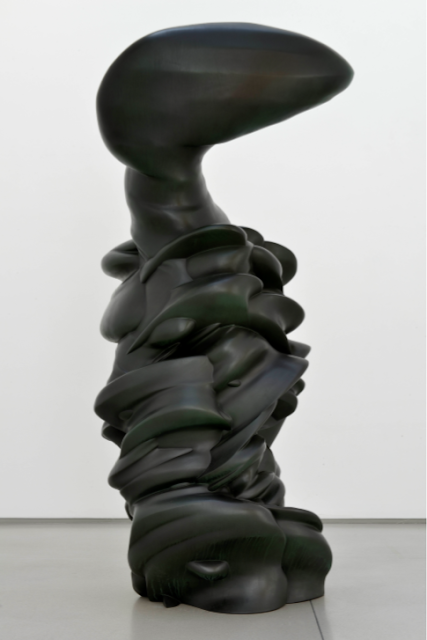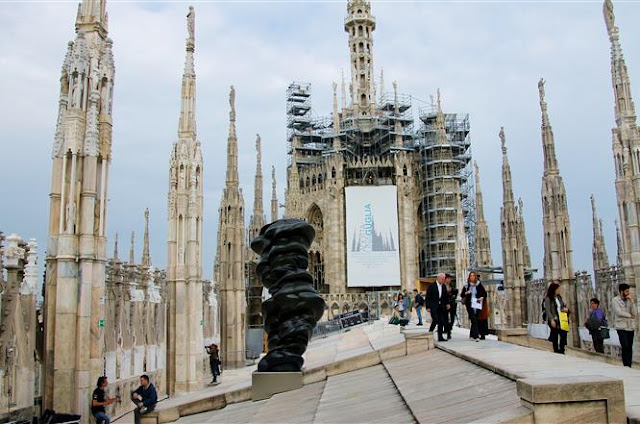TONY CRAGG: DIALOGUE WITH THE DUOMO FOR THE VERY FIRST TIME ON
THE TERRACES A CONTEMPORARY ART EXHIBITION FOR EXPO 2015
April 16, 2015 – October 31, 2015
TONY CRAGG. DIALOGUE WITH THE DUOMO FOR THE VERY FIRST
TIME ON THE TERRACES A CONTEMPORARY ART EXHIBITION FOR EXPO 2015
Duomo of Milan Terraces
April 16, 2015 – October 31, 2015
In collaboration with 8ARS by Stefania Trolli and
Arturo Nardini The Duomo Cathedral, in its religious, cultural and
historical dimension, has always measured itself with the language of evolving
culture through the centuries.
A great Contemporary Art event held for the first time
on the Terraces of the Duomo of Milan: Tony Cragg, an internationally renowned
artist, with his works animated by movements ascending towards the sky,
competes with the Spires and the centuries old history of the Cathedral.
An exhibition like this has never been set up over the
Duomo Terraces because of the arduous transport of such big sculptures to an
unusual place and inaccessible height settled in the heart of the city. These
works of art has been raised up to the Terraces through a crane, in the same
way as marble blocks are raised during the activity of the Veneranda Fabbrica
working sites.
All of this to make the best of the dialogue between
the Duomo and the art languages,
bringing Tony Cragg, sculptor of primary importance in
the artistic world, to such an important and evocative place in Milan. This
work requires sensitivity, great skills and the ability to perceive the deep
network of invisible correspondences that rules reality: carving the marble,
Tony Cragg wants to build a bridge, a link between apparently far apart
dimensions. Only apparently. The marble assimilates the rhythm of time and
through the artist’s work it is shaped into forms and contours that vibrate to
the infinite: the sculpture is movement, pure and tangible, substance that
carries a transcendent power without equal. An event such as Expo wants to give
vigour to all the cultural energy that the city can express. Milan must
represent itself in all of its cultural dimension looking forward to the future
and to the international context: it will be an essential opportunity to
experience these skills. The Duomo Cathedral is the summary of these
values.
Tony Cragg’s sculptures, starting from the
installation of Paradosso, inspired by the Madonnina and inaugurated inside the
Duomo Cathedral the last 4th November 2014 where will remain during the whole
Expo semester, are characterized by shapes aiming to the infinite, where
everyone can find its own cultural and artistic dimension as a sign of personal
free interpretation. Everyone visiting the Terraces during the Expo
semester will be able to be part of this experience using their own
creative freedom.
http://www.duomomilano.it/en/event/2015/04/16/tony-cragg-dialogue-with-the-duomo/431c6032-32a5-46b1-8ee2-d873cb8c2a4e/
You may visit Tony Cragg last exhibition news at Galerie Thaddeaus Ropac Pantin Paris to click below link.
http://mymagicalattic.blogspot.com.tr/2016/05/tony-cragg-at-galerie-thaddaeus-ropac.html
You may visit Tony Cragg last exhibition news at Galerie Thaddeaus Ropac Pantin Paris to click below link.
http://mymagicalattic.blogspot.com.tr/2016/05/tony-cragg-at-galerie-thaddaeus-ropac.html
SPLIT FIGURE
2014
Fiberglass
Dimensions:
320x170x178
© 2015 Tony
Cragg
ELLIPTICAL
COLUMN 2009
Stainless Steel
Dimensions:
290x60x60
© 2015 Tony
Cragg
CURRENT
VERSION 2010
Fiberglass
Dimensions:
338x160x170
© 2015 Tony
Cragg
FALSE IDOLS
2011
Bronze
Dimensions:
233x105x105
© 2015 Tony
Cragg
DUOMO DI MILANO
THE VENERANDA FABBRICA DEL DUOMO DI MILANO AN
IMPRESSIVE STORY LASTING 628 YEARS
For over six centuries, the Duomo has been famed
throughout the world as a treasure chest of masterpieces of sculpture and
architecture and, even more, as the best-known and most easily recognisable
symbol of the city of Milan. Artists,
craftsmen, church men, nobles and common people have transferred knowledge and
emotions to it, in a harmony worthy of a great Mozartian score: always alive,
but always consistent, always ancient and always new. The Veneranda Fabbrica del Duomo di
Milano is the historical institution charged with the conservation and
enhancement of the Cathedral. Set
up in 1387 by Gian Galeazzo Visconti, Lord of Milan, to design and construct
the cathedral, it has continued to work for over half a millennium, with great
sense of responsibility, to preserve the Duomo, finding the resources required
for its maintenance.
The Fabbrica takes care of all the maintenance and
restoration work on the Cathedral, at the Candoglia Quarries, the Marble
workers' site and the Duomo construction site. It also promotes initiatives to
publicise the activities of the various cultural assets: the priceless Archives
and Library, the Grande Museo del Duomo and the Musical Chapel. By creating the
cycle of events in the Cathedral and on the Terraces, the Fabbrica has given
back to the Duomo its role as the focus of cultural and social life in Milan,
also awakening Italian and foreign visitors to the need to constantly strive to
preserve this matchless artistic asset that is part of the heritage of the
whole world.
In October 2012, lastly, the Fabbrica launched a new
fund-raising campaign called “Get your Spire”, to continue to fund the most
urgent structural work involving different sites, including the Main Spire, the
four smaller gugliotti, the 129 spires, the 'falconature' or decorations at the
top of the facade, repairs to the covering spans of the roof of the Duomo,
cleaning of the interior of the Cathedral, restoration of the ciborium and of
the Madonna dell’Albero and San Giovanni Bono Altars.
DUOMO DI MILANO
THE LUKE
2008
Carbon Fiber
Dimensions:
360x192x180
© 2015 Tony
Cragg
PARADOSSO 2013
Marble
Dimensions:
300x122x140
© 2015 Tony
Cragg
PARADOSSO BY TONY CRAGG,
Dimensions: 300x122x140, stone 3400 kg Duomo di Milano
I was surprised at the idea of being able to work with
this historical institution, the Veneranda Fabbrica del Duomo of Milan, because
as sculptor it represents truly a unique opportunity. I'm not a
figurative artist, I’m not somebody who makes figures, as in the traditional
sense. Obviously, the human figure is one of the most interesting things around
us and I’m interested in that, but my work is very often about the structures
that lay beyond, behind and underneath the things we see. It is not a question
of just showing a figure … I have an idea that underneath all my work:
it’s a precise formal structure and then the suggestion of the figure
gets more and more lost inside of it. This work - which we have now
entitled "Paradosso” – has that thing. What we see is only a measure of
our own perception, which is a relative thing, it’s not really reality, it
doesn’t show any of the amazing internal things or the big things that
surround us, the causes to be here in this moment, and that is something we should
mature through sculpture. Anything that exist, as a physical and material
thing, has an effect on our lives, on the people around it. We live our entire
life breathing air which is material, existing in material. Consequently, every
form, every facial expression on our face has a message, forms are themselves
messages that we need to decode. My works is about the internal structure, it’s
about energies, reasons and causes that we - in our small position - cannot
possibly understand and grasp.
Of course, the situation on the roof of the Cathedral
is unusual for contemporary art. But when you're up there, you're surrounded by
sculptures anyway and you realize that sculpture is a part of a religious
building, a part of the Duomo of Milan in particular. So the invitation to act
and make an exhibition next year, for this great ceremony celebration - Expo
2015 - it’s an honor, it’s a challenge, I’m still making the work. “Paradosso”
has taken almost two years to prepare until it can stand here today. So it’s a
lot of work and I’m very excited to be involved in this creative endeavor,
which is an experiment in some ways.
What I would like to achieve in my work is a sense of
dynamic, internal energy of something that drives existence. I feel that it
does express this kind of energy and dynamic, which is what I would like to see
in my work. It suggests that there are forces that we can’t grasp and
understand just with our simple eyes, with a simple vision. When I came in the
Duomo I thought "That’s it".
Tony Cragg
EVER AFTER 2006
Bronze
Dimensions:
324x125x115
© 2015 Tony
Cragg
TONY CRAGG
Tony Cragg is one of the world’s most
foremost sculptors. Constantly pushing to find new relations between people and
the material world, he works with stone, wood, glass, stainless steel,
aluminium, cast bronze and cast iron, and found objects, from plastic consumer
goods to rubbish from the streets. His early, stacked works present a
taxonomical understanding of the world, and he has said that he sees manmade
objects as “fossilized keys to a past time which is our present”. So too, the
floor and wall arrangements of objects that he started making in the 1980s blur
the line between manmade and natural landscapes: they create an outline of
something familiar, where the contributing parts relate to the whole. Cragg has
always had, from an early age, a passionate interest in science and natural
history and worked as a young man as a lab technician at the National Rubber
Producers Research Association (1966–68), an experience that is reflected in
his vigorous approach to material. He has said, “I see a material or an object
as having a balloon of information around it” (1992). For him form and meaning
are interdependent, any change in form changes the ‘balloon of information” and
vice versa, so that any change in materials also changes meaning and
significance. Cragg understands sculpture as a study of how material and
material forms affect and form our ideas and emotions.
This is exemplified in the way in which Cragg has worked and reworked two broad bodies of work he calls Early Forms and Rational Beings. The Early Forms explore the possibilities of sculpturally reforming familiar objects such as containers into new and unfamiliar forms producing new emotional responses, relationships and meanings. Rational Beings explore the relationship between two apparently different aesthetic descriptions of the world; the rational, mathematically based formal constructions that go to build up the most complicated of organic forms that we respond to emotionally. The human figure being the prime example of something that looks ultimately organic eliciting emotional responses, while being fundamentally an extremely complicated geometric composition of molecules, cells, organs and processes. Cragg’s work does not imitate nature and what we look like, rather it concerns itself with why we look like we do and why we are as we are.
Tony Cragg was born in Liverpool, UK in 1949 and has lived and worked in Wuppertal, Germany since 1977. He has a BA from Wimbledon School of Art (1973) and an MA from the Royal College of Art (1977). Among many major solo shows he has exhibited at CAFA Museum in Beijing (2012), the Scottish National Gallery, Edinburgh (2011), Tate Gallery Liverpool, UK (2000), Museo Nacional Centro de Arte, Reina Sofia, Madrid (1995), Stedelijk van Abbemuseum, Eindhoven (1991) and Tate Gallery, London (1988). He represented Britain at the 53rd Venice Biennale in 1988 and in the same year was awarded the Turner Prize at the Tate Gallery, London. He has been a Professor at Ecole Nationale Superieure des Beaux Arts, Paris (1999-2009) and Professor at Kunstakademie, Dusseldorf, 2009 – present. He was made a CBE in 2003, elected a Royal Academician in 1994; received the Praemium Imperiale for Sculpture, Tokyo (2007) and he was Awarded the 1st Class Order of Merit of the Federal Republic of Germany (2012).
This is exemplified in the way in which Cragg has worked and reworked two broad bodies of work he calls Early Forms and Rational Beings. The Early Forms explore the possibilities of sculpturally reforming familiar objects such as containers into new and unfamiliar forms producing new emotional responses, relationships and meanings. Rational Beings explore the relationship between two apparently different aesthetic descriptions of the world; the rational, mathematically based formal constructions that go to build up the most complicated of organic forms that we respond to emotionally. The human figure being the prime example of something that looks ultimately organic eliciting emotional responses, while being fundamentally an extremely complicated geometric composition of molecules, cells, organs and processes. Cragg’s work does not imitate nature and what we look like, rather it concerns itself with why we look like we do and why we are as we are.
Tony Cragg was born in Liverpool, UK in 1949 and has lived and worked in Wuppertal, Germany since 1977. He has a BA from Wimbledon School of Art (1973) and an MA from the Royal College of Art (1977). Among many major solo shows he has exhibited at CAFA Museum in Beijing (2012), the Scottish National Gallery, Edinburgh (2011), Tate Gallery Liverpool, UK (2000), Museo Nacional Centro de Arte, Reina Sofia, Madrid (1995), Stedelijk van Abbemuseum, Eindhoven (1991) and Tate Gallery, London (1988). He represented Britain at the 53rd Venice Biennale in 1988 and in the same year was awarded the Turner Prize at the Tate Gallery, London. He has been a Professor at Ecole Nationale Superieure des Beaux Arts, Paris (1999-2009) and Professor at Kunstakademie, Dusseldorf, 2009 – present. He was made a CBE in 2003, elected a Royal Academician in 1994; received the Praemium Imperiale for Sculpture, Tokyo (2007) and he was Awarded the 1st Class Order of Merit of the Federal Republic of Germany (2012).
http://www.lissongallery.com/artists/tony-cragg












































































